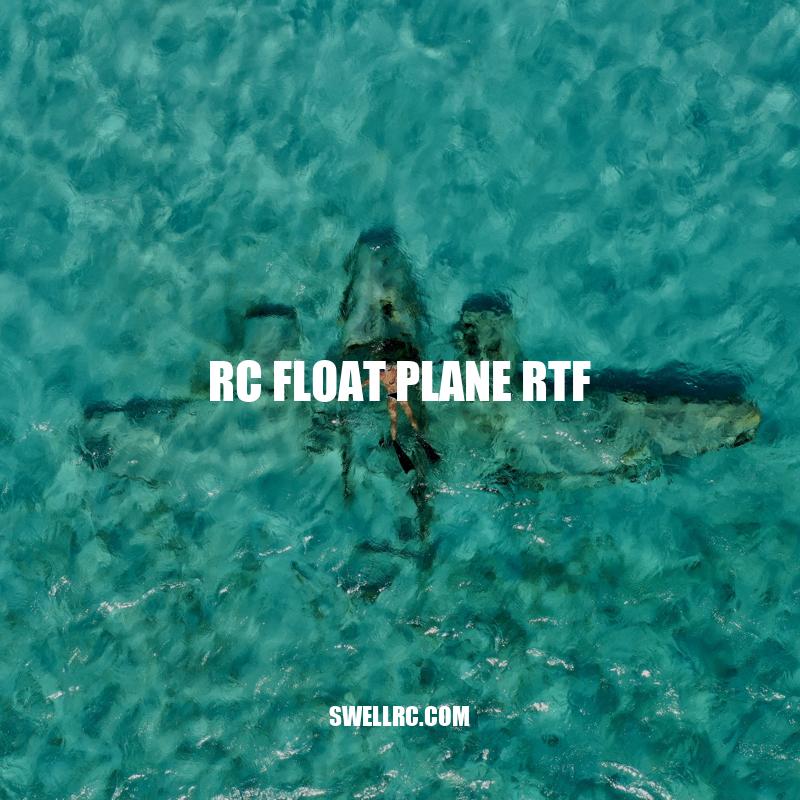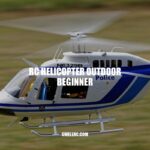Mastering the Waters: Beginner’s Guide to RC Float Plane RTF
RC float planes are an exciting and challenging hobby for aviation enthusiasts. These radio-controlled aircraft are designed to take off and land on water, requiring a unique set of skills to navigate the water’s surface and achieve stable flight. RC float planes come in various sizes and shapes, with some suitable for beginners and others geared towards advanced users. As the name suggests, Ready-to-Fly (RTF) kits are available for RC float planes, making it easy for beginners to get started without worrying about assembling individual parts. RC float planes are made of lightweight but durable materials and feature high wing placement and aerodynamic designs to promote smooth and stable flight. It is worth investing in waterproof electronics, as these planes will inevitably face exposure to water.
Choosing the right RC float plane for your skill level, flying preferences, and budget is crucial to ensure an enjoyable experience. If you are a beginner, it is advisable to start with a smaller and less complex plane that is easy to fly, giving you the chance to learn the ropes before upgrading to more advanced models. Advanced users can choose more complex planes that allow for advanced maneuvers such as loops and barrel rolls. Regardless of your skill level, it is essential to follow manufacturer instructions for proper assembly and maintenance of your RC float plane. It is also important to follow safety guidelines to avoid accidents, such as flying at a safe distance from people, animals, and power lines and avoiding water currents.
RC float planes are designed with specific features that make them ideal for water landings and stable flight. Some of the notable features to look out for when purchasing an RC float plane include:
- Lightweight yet durable materials: Most RC float planes are made of materials that are lightweight and durable, allowing for easy maneuverability and resistance to damage during landings.
- High wing placement: The high placement of wings on the plane allows for smoother takeoff and landing on water surfaces.
- Aerodynamic design: This design feature promotes stable and smooth flight, ensuring that the plane stays in the air for longer and reducing the chances of crashes and damage.
- Waterproof electronics: Since RC float planes can be exposed to water during landings and flights, having waterproof electronics is crucial to avoid damage and ensure reliable performance.
- Brushless motor: These are more powerful and efficient than brushed motors, providing greater precision and control during flights.
For those new to RC float planes, it is advisable to opt for an RTF kit that comes complete with all the necessary components, including the plane, controller, battery, and charger. Some popular options include the Flyzone DHC-2 Beaver, the Volantexrc TrainStar, and the HobbyZone Sport Cub S2. These models are perfect for beginners, as they are easy to control and have durable bodies designed to withstand crashes and other impacts. For more advanced users, there are more complex RC float planes available, such as the Great Planes U-Can-Do 3D, which is perfect for performing advanced aerobatic maneuvers.
What are some popular options for RTF kits for beginners in RC float planes?
If you’re just starting out on your journey into the world of remote control (RC) float planes, it can be overwhelming to know which radio-controlled plane kit to start with. A great starting point for beginners are RTF (ready-to-fly) kits. These kits come with everything you need to get started—excluding batteries—and are a great way to get a feel for the hobby before investing in more advanced models.
One popular option for beginners is the Flyzone Beaver RX-R. The Beaver is a classic Canadian bush plane, versatile and able to handle both water and land landings. This model kit comes with pre-installed motor and servos, as well as a lightweight airframe that’s easy to launch and fly.
Another excellent option for beginners is the HobbyZone Sport Cub S RTF. This kit includes a lightweight design that is both sturdy and easy to fly. The Sport Cub S RTF, features SAFE Technology, which is ideal for beginners learning to fly RC planes.
The third option on our list is the E-flite UMX Timber BNF Basic. This kit is ideal for beginners who have minimal experience flying RC planes. Despite its compact size, the UMX Timber has a powerful motor, and electronic stabilization, making it easy for beginners to fly.
Other options worth considering include the Floatzone Fiesta II EP Rx-R, the Flitework Red Bull Edge 540 790mm, and the Phoenix Model Stuka Ju 87 GP/EP/Gas ARF. Each option offers unique features ideal for beginners learning to fly RC float planes.
Remember that when selecting a radio-controlled plane kit, it’s important to choose one that’s appropriate for your skill level and flying needs. With a bit of research and some patience, you’ll find the perfect RTF kit to get started on your exciting adventure into the world of RC float planes.
Choosing an RC float plane RTF depends on several factors, including your skill level, the type of flying you want to do, and your budget. Here are some tips to consider when choosing an RC float plane RTF:
- Skill level: If you are a beginner, it is advisable to start with a smaller and less complex plane that is easy to fly.
- Type of flying: If you want to perform advanced maneuvers such as loops and barrel rolls, you should select a more advanced and complex plane that can handle the demands of these maneuvers.
- Budget: RC float planes RTF can be expensive, so it is essential to choose one that fits your budget.
- Size: Smaller planes are easier to handle and are more suitable for learners, while larger planes can perform advanced maneuvers but require better skills and experience.
- Build: Some planes require assembly, so it is necessary to assess your skill level and tools before purchasing them.
Top RC Float Planes RTF for Beginners:
| RC Float Plane | Price | Description |
|---|---|---|
| Flyzone DHC-2 Beaver | $199.99 | Easy to control, durable body, and a stable in-flight experience |
| Volantexrc TrainStar | $139.99 | Perfect for beginners, easy to fly, and has a durable build |
| HobbyZone Sport Cub S2 | $159.99 | Easy to fly, durable, and has a lightweight design suitable for beginners |
Top RC Float Planes RTF for Advanced Users:
| RC Float Plane | Price | Description |
|---|---|---|
| Great Planes U-Can-Do 3D | $399.99 | Perfect for advanced aerobatic maneuvers, high-quality construction, and stable in-flight experience |
| Volantexrc V792-4 ATOMIC | $299.99 | Suitable for experienced pilots, and ideal for racing and high-speed flights |
| FMS Beaver | $334.99 | Perfect for advanced users, and has a durable and rugged design suitable for rough landings |
It is important to invest in a quality RC float plane RTF from a trusted manufacturer and supplier. Doing so ensures that you have access to reliable customer support and quality spare parts. You can find great RC planes RTF on Motion RC.
‘What are some features to consider when selecting an RC float plane RTF’?
When it comes to selecting an RC float plane RTF (ready-to-fly), there are a lot of factors that you should consider. The most important feature you should look for in an RC float plane is its durability. You want to make sure it can withstand crashes and rough landings on water. Additionally, the size and weight of the plane also make a big difference in how it flies and handles on the water.
Another notable feature is the plane’s motor power and battery life. A strong motor will help you get through tough air and water conditions, while ample battery life can enable you to play with the plane without worrying about running out of power.
The availability of replacement parts and accessories is also a crucial factor, particularly if the plane is for frequent usage. A good user manual that comprehensively details the assembly process, operation, and maintenance of the aircraft can save you a lot of trouble in the long run.
Finally, it’s also essential to consider the level of expertise that the plane demands, especially if you are a beginner. You should look for a plane that is easy to control, stable, and allows you to gradually work your way up into more complex maneuvers.
When it comes to selecting the perfect RC float plane RTF, the above features could be the deal-breaker between a frustrating experience and an enjoyable experience. Take the time to research and choose a plane that fits your skill level, preferences, and ambitions for limitless fun with your new toy.
RC float planes require proper maintenance and care to ensure they perform well and last long. Here are some maintenance tips to consider:
- Cleaning: After each use, it is essential to clean your plane with a damp cloth to remove dirt and debris. Avoid using harsh chemicals that could damage your plane’s exterior or components.
- Checking for damages: Always check your plane for damages before and after each flight. Look out for cracks, dents, and scratches on the exterior, as well as any loose or missing screws, and damaged propellers or wings.
- Tightening screws and bolts: Over time, screws, bolts, and other components may come loose. Be sure to tighten them as necessary to avoid damage to your plane’s structure and components.
- Storing your plane: When not in use, store your plane in a cool, dry place to avoid exposure to moisture and sunlight. Keep it away from dust and debris to protect the exterior and components from damage.
Safety is also critical when flying RC float planes. Here are some safety tips to follow:
- Avoid water with high currents: Strong water currents can sweep your plane away and damage it. Preferably fly your plane in calm water, free from strong currents.
- Keep a safe distance from people and animals: When flying your RC float plane, stay away from people and animals to avoid injuring them or damaging your plane.
- Avoid flying near power lines: To avoid accidents, never fly your RC float plane near power lines, buildings, or other structures that could damage it.
- Follow manufacturer’s instructions: Always follow the manufacturer’s instructions when assembling and flying your plane. This minimizes the risk of accidents and ensures your plane is in good condition.
It is essential to take maintenance and safety seriously to get the most out of your RC float plane and reduce accidents. Websites such as Horizon Hobby, RC Planet, and Amazon offer a range of quality RC float planes and spare parts, as well as useful resources to help you with assembly, maintenance, and flying tips.
What are some safety tips for flying RC float planes?
Flying an RC float plane is an exciting experience that requires skill and safety precautions to ensure an enjoyable and incident-free flight. Here are some useful safety tips for flying your RC float plane:
1. Scout the area before flying: The first thing to do is to scout the area where you will be flying your RC float plane. Look for any obstacles like trees, buildings, or power lines that could impede your flight.
2. Check the weather: Before you take to the skies, check the weather forecast for the day. If it’s windy or there’s a storm coming up, it’s better to postpone your flight.
3. Make sure your equipment is in good condition: Before taking off, it’s important to check your RC float plane to ensure that everything is in good working order. Check the battery, propeller, and transmitter to ensure that they are in good condition and properly connected.
4. Always check battery life: Flying an RC float plane means ensuring that the battery of your plane is functioning to its full capacity. Always check the battery life before flying, so it does not run out of power while you are in mid-air.
5. Stay within your sight: Make sure that your RC float plane stays within your sight. Don’t fly too far where you cannot see it, as it could crash, and you may not be able to retrieve it.
6. Avoid flying over people or property: Avoid flying your RC float over people or property, as it could harm somebody or their property if something goes wrong.
By following these safety tips, you can enjoy your RC float plane flying experience and ensure that your flight is as safe as possible.
Conclusion
In conclusion, RC float planes are a thrilling and challenging hobby that combines aviation and water sports. With various sizes, shapes, and complexities, there is always a suitable plane for an enthusiast regardless of their skill level. When selecting your RC float plane, always consider your safety, budget, and type of flying you want to perform to ensure you have an enjoyable and fulfilling experience. Remember to maintain and care for your plane to improve its longevity and performance. Keeping your plane clean, checking for damages, tightening screws and bolts, and storing it in a cool, dry place is crucial for keeping your plane in top shape. Follow these safety and maintenance tips and have a safe and enjoyable experience flying your RC float plane.



